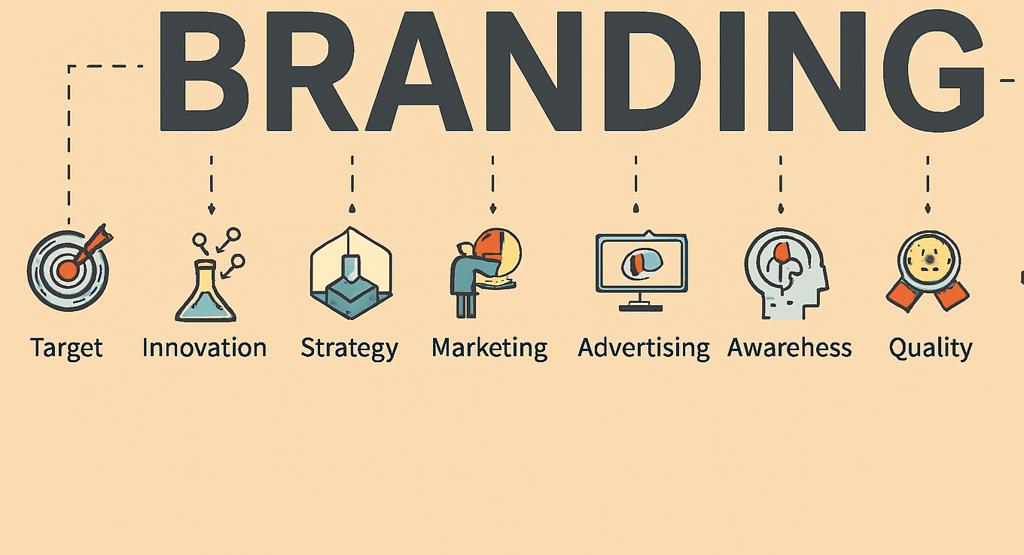What Is Branding and Why Is It Important?
Discover what branding really means and why it's essential for building trust, recognition, and long-term business success.
DIGITAL MARKETING
8/15/20254 min read


🌟 What Is Branding? Understanding Its Importance
In today’s hyper-competitive marketplace, branding is no longer just a buzzword—it’s the backbone of every successful business. Whether you're launching a startup, scaling a mid-sized company, or revitalizing an established enterprise, understanding branding is essential to building trust, recognition, and long-term value.
🔍 What Is Branding?
Branding is the process of creating a unique identity for a business, product, or service. It encompasses everything from your logo, color palette, and typography to your messaging, tone of voice, and customer experience. But more than just visuals, branding is about perception—how people feel when they interact with your brand.
Branding – The design of distinct brand identities for business, marketing, and advertising. Featuring standout projects hand-picked by our curation team.
This definition highlights the creative and strategic essence of branding. It’s not just about looking good—it’s about standing out, being memorable, and communicating your values clearly.
💡 Why Is Branding Important?
Branding plays a pivotal role in shaping how your business is perceived. Here are some key reasons why branding matters:
1. Creates Recognition and Recall
A strong brand identity helps customers recognize your business instantly. Think of Apple’s sleek design or Nike’s iconic swoosh—these elements stick in our minds and evoke specific emotions.
2. Builds Trust and Credibility
Consistent branding signals professionalism and reliability. When your brand looks polished and communicates clearly, customers are more likely to trust you and choose your offerings over competitors.
3. Differentiates You from Competitors
In crowded markets, branding helps you carve out a unique space. It allows you to highlight what makes your business different—whether it’s your values, your story, or your approach to solving problems.
4. Drives Customer Loyalty
People don’t just buy products—they buy experiences and identities. A well-crafted brand fosters emotional connections, encouraging repeat business and word-of-mouth referrals.
5. Supports Marketing and Advertising
Effective branding amplifies your marketing efforts. When your brand identity is clear and compelling, your campaigns resonate more deeply, leading to better engagement and conversion rates.
🎨 Elements of a Strong Brand
To build a powerful brand, several key elements must work in harmony. At the forefront is your logo, the visual symbol that represents your brand identity—it should be simple, memorable, and versatile across platforms. Complementing this is your color palette, a carefully chosen set of hues that evoke the right emotions and ensure visual consistency. Equally important is typography, as the fonts you select should reflect your brand’s personality while maintaining clarity and readability. Your voice and tone shape how your brand communicates—whether it's formal, friendly, witty, or authoritative, consistency here builds trust. Then comes your messaging, the core statements that articulate your mission, vision, and value proposition, helping audiences understand what you stand for. Finally, your customer experience—from your website and social media to packaging and service—must consistently reflect your brand’s essence, creating a cohesive and memorable journey for every interaction.
🚀 Branding in Action: Real-World Examples
Let’s look at how branding transforms businesses:
Starbucks: Beyond coffee, Starbucks sells a lifestyle. Its branding—earthy tones, cozy ambiance, and personalized service—creates a sense of belonging.
Tesla: Tesla’s branding revolves around innovation and sustainability. Its minimalist design and futuristic messaging position it as a leader in electric mobility.
Zomato: In India, Zomato’s witty tone, bold visuals, and hyper-local campaigns have made it a household name in food delivery.
These brands don’t just sell products—they sell stories, values, and experiences.
🧠 Strategic Branding: More Than Just Design
While visual identity is crucial, branding also involves strategic thinking. This includes:
Audience Research: Understanding your target market’s needs, preferences, and behaviors.
Competitive Analysis: Identifying gaps and opportunities in your industry.
Brand Positioning: Defining your unique value and how you want to be perceived.
Brand Architecture: Organizing multiple products or services under a cohesive brand system.
When done right, branding becomes a strategic asset that drives growth, resilience, and adaptability.
🌐 Branding for SEO and Digital Success
In the digital age, branding and SEO go hand in hand. A consistent brand presence across your website, social media, and content marketing improves:
Search Engine Rankings: Branded keywords and consistent messaging boost visibility.
Click-Through Rates (CTR): Strong branding increases trust, leading to more clicks.
User Engagement: Branded content keeps users on your site longer, reducing bounce rates.
To optimize your brand for search engines, focus on:
Using branded keywords in titles, meta descriptions, and headers
Creating high-quality content that reflects your brand voice
Building backlinks from reputable sources that recognize your brand
🛠️ Building Your Brand: Tips for Success
Ready to build or refine your brand? Here are some actionable tips:
Define Your Brand Purpose: What problem do you solve? Why do you exist?
Know Your Audience: Tailor your branding to resonate with your ideal customers.
Be Consistent: Use the same colors, fonts, and tone across all platforms.
Tell Your Story: Share your journey, values, and vision authentically.
Evolve Strategically: Rebrand when necessary, but stay true to your core identity.
✨ Final Thoughts
Branding is not a one-time task—it’s an ongoing journey of discovery, refinement, and connection. It’s the soul of your business, the promise you make to your customers, and the legacy you leave behind.
Whether you're designing a logo, crafting a tagline, or launching a campaign, remember: branding is about meaning. It’s about creating something that people believe in, relate to, and remember.
So, invest in your brand. Shape it with intention. And let it speak volumes—without saying a word.
